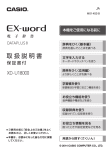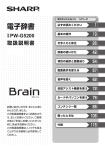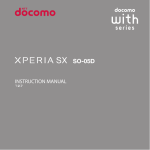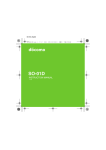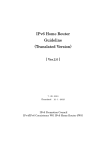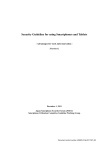Download 簡易マニュアル(英語)
Transcript
RJA532512-001V01 • If you have commercially available eneloop batteries or rechargeable EVOLTA batteries loaded, use and to select the battery type, and then press . • If you have commercially available EVOLTA alkaline batteries loaded, select ●アルカリ電池 (Alkaline Batteries). MO1412-A CASIO Electronic Dictionary Quick Guide (XD-K Series) The contents of this Quick Guide apply to the CASIO XD-K Series Electronic Dictionaries. Most illustrations and screen shots show the XD-K8500. 7 Use the time setting screen to configure time settings. • The screen shots and product illustrations shown in this manual may be different from those of the actual product. Also note that some keys and screen indicators are shown in simplified form. Example: → , 8 Press Loading Batteries for the First Time Load the two AA-size batteries that come with the electronic dictionary before trying to use it. 1 2 3 4 Remove the battery cover. • While pressing down on the two locations shown in the illustration, slide the battery cover in the direction indicated by the arrows. Load two batteries. 5 Toggles power on and off. Press the Scroll screen contents up and down. Pressing and then a scroll key scrolls to next definition or explanation screen. ⑤ Press ⑥ Remove the stylus from the side of the electronic dictionary and then press the RESET button. Stylus ⑦ RESET button Unfold the electronic dictionary. ⑧ These keys move the selection highlighting or cursor up, down, left, or right. ⑪ (Setup/Delete) Key Deletes the character at the current cursor location. Press after to display a screen for changing the setup of the electronic dictionary. ⑫ Letter Keys again to turn off power. Display You can touch the screen to select an on-screen item, swipe it to scroll to another screen, or input characters by handwriting them on the screen. ⑭【ノート】(Note) • When performing a display screen touch operation, be sure to support the back of the display with your hand. * Touch to use the ノート (Note) function. 1 ⑮【さらに検索】(Search Again) Quick Palette buttons You can quickly perform various operations by touching buttons with the stylus. Touch this button when performing split screen search 2, refine/specific word order search 3, or spelling/original form search. 4 * ⑯【文字サイズ】(Text Size) * * Cycles through available screen text sizes. ⑰【 音声】(Audio) Performs the same functions as the ⑧ (Audio/Guide) key. ⑱【ジャンプ】(Jump) Performs the same functions as the ⑥ (Jump) (Volume Level ( + )) key. ⑲【メニュー】(Menu) ⑲ ⑱ ⑰ ⑯ ⑮ ⑭ ⑬ ① Toggles between the メニュー (Menu) screen and the 学習帳 (Workbook) screen. Note function lets you add handwritten *1 The memos to electronic dictionary note screens, and to write on displayed dictionary screens. Text you write and figures you draw can be saved for later recall. 2 You can display another dictionary at the bottom of a definition or explanation screen, and look up a term in two dictionaries simultaneously. 3 On a 成句検索 (Phrase Search) or 例文検索 (Example Search) list screen, you can add terms and specify the word order to refine a search. 4 Inputting characters for 見出し語検索 (Headword Search) with a dictionary that has スペルチェッ ク (Spell Check) and then touching【さらに検索】 will display a term whose spellings resemble your input or a term that is thought to be the spelling original form of your input. * * ② ⑫ ③ Means this: A definition or explanation continues off the top, bottom, left, or right of the screen. Use the arrow keys to scroll the screen. There is an explanation for the word (Explanation) where the indicator is located. There is a compound term that (Compound Term) uses kanji you are looking up. There is a phrase or compound (Phrases/Compound expression that uses the term you are looking up. Expression) With some electronic dictionary will appear if optional models, (Phrase) content is installed. There is an example that uses the (Example) term you are looking up. Native speaker pronunciation is available for the contents to the right or below this indicator. Native speaker pronunciation is available. (True Voice) Synthetic voice reading is available. (Reading) Pronunciations are available for the (Pronunciation English term on the screen. Search) The language whose pronunciation is applied for pronunciations and (English) readings There is related information for the term you are looking up in the current dictionary. Jump function in use (Jump) History function in use (History) Textbook typeface zoom in use (Zoom) Guide function in use (Guide) (Display All) Indicates the display method when (Word Order) using 例文検索 (Example Search) or 成句検索 (Phrase Search). (Continuous) Screen Touch Operation Tips Performs the same functions as the ⑦ (Back/List) key. Recording microphone The following explains the meanings of the different items (indicators, icons, buttons) that appear on the display. Enter letters and numbers. ⑬【戻る/リスト】(Back/List) Arrow keys After confirming that アルカリ電池 (Alkaline Batteries) is selected for 電池設定 (Battery Setting), press . (Translate/Execute) Key ⑩ Arrow Keys Keyboard 6 (Audio/Guide) Key Press to play native speaker or synthesized pronunciation or to compare your pronunciation with native speaker pronunciation. Press after to view guide information. Display This causes the 電池設定 (Battery Setting) screen to appear. • If the message 液晶保護フィルムが正しく貼ら れていない...(Display screen protective film may not be affixed properly...)appears on the display, remove the protective film (option) from the display screen. If there is no protective film on the display screen, refold the electronic dictionary panels and then repeat steps 4 and 5 again. (Back/List) Key • Back-steps through previous operations. • Press while a dictionary’s initial screen is displayed to return to the メニュー (Menu) screen. key to turn on power. Quick Palette icons You can quickly perform various operations by touching icons with the stylus. The Quick Palette icons along the left side of the display depend on the function being used. (Jump) (Volume Level (+)) Key From a definition or explanation screen, jumps to a related item in the same dictionary or looks up a term that used on the screen in a different dictionary. When adjusting the pronunciation volume level, press to raise the level. If there is no voice output, press and then this key. Applies input characters or the item selected on the screen. General Guide Replace the battery cover. (History) (Volume Level (-)) Key Accesses history data. When adjusting the pronunciation volume level, press to lower the level. If there is no voice output, press and then this key. ⑨ • Power also turns on when you press a dictionary/mode key. 2 (Scroll) Keys ⑪ * ⑤⑥⑦⑧ ⑨ Display • Strong pressure is not required when performing display screen touch operations. • Use English input for unaccented alphabetic characters. To input this: internet ? • To delete a character, use and to move the cursor to the character, and then touch【削除】(Delete). Type this: • To input a small character while the Japanese syllabary screen is displayed, input the desired character and then touch【小文字】(Small character). ~ ■ Accented Characters All alphabetic characters are input in lower-case, regardless of their normal capitalization. • For the German “ß”, input “ss”. • For other characters that normally include a diacritic, input the character without the diacritic. Example: “à” → “a”, “ê” → “e”, etc. • For the French “ç” input “c”, and for “œ”, input “oe”. • Input hyphenated terms as single words, without a hyphen. To look up “heaven-sent”, for example, input “heavensent”. • When inputting a term that consists of multiple words, input the words without any spaces. To look up “in orario”, for example, input “inorario”. • When entering a noun that is normally accompanied by an article, enter the noun only without the article. To look up “die Elbe” for example, input “elbe”. Inputting Hangul Characters To input this: Handwritten Input Use the stylus to write the character on the screen. • Touch the Quick Palette【手書き】(Handwriting) icon to display character input cells. • Write a character into a cell and then touch【認識】 (Recognize). • With some search methods, like 単漢字 / 熟語を手書き入 力から探す (Kanji/Compound Term Handwritten Input Search) ( 新漢語林 (Japanese Kanji Dictionary)), you can enter search terms using handwriting input only. Character Input Mode GGG Inputting Chinese Characters (Pinyin) 1 2 3 4 To input this: ming2tian1 (míng tiān・明天 ) Indicator The indicators described below appear on the screen to show the current input mode. Type this: 0 Supported Input Characters Hiragana Katakana Kanji Simplified Chinese Hangul Indicator Type this: T I A N Supported Input Characters Alphabetic Alphabetic and accented alphabetic Russian 【書き直し】 W Q • To specify one of the four Chinese tones ( , , , ) or the “toneless” tone ( ), press and release , and then press the key that corresponds to the tone you want to specify. The four Chinese tones and the “toneless” tone are indicated by numbers on the display. • To input “ü”, press V . Inputting Russian Characters (Rewrite) 【削除】(Delete) 【認識】(Recognize) • The number of cells that appear on the screen depends on the type of characters that can be input. Correcting Character Input • The example here uses the screen (character input cells) that are displayed after【手書き】(Handwriting) is touched. Example: After mistakenly inputting 喜怒衰楽 instead of • For stylus character input, be sure to use only the stylus that comes with your electronic dictionary. • When using your finger for input, do not tap with your fingernail. Keyboard Input • Alphabetic and Russian characters are input using lower case. • Except for certain models, Hangul, Chinese pinyin, and Russian characters are not printed on the keys. • To input numbers, touch the on-screen number keys or handwrite numerals into the input cells. See “Handwritten input” for more information. Note that you can also use the electronic dictionary’s keys to input numbers, but numbers are not printed on the keys. Inputting Japanese Characters • Use alphabetic characters to input Japanese. To input this: いんかん closes the input screen. If the input • Touching screen was displayed by touching【50 音大】(large Japanese syllabary keyboard), close the input screen by pressing . Indicator 喜怒哀楽 • Avoid applying excessive pressure during touch operations and input. Strong pressure can cause cracking or breaking of LCD panel. Type this: さんぽ or To input this: хобби Type this: Input field 1 • To input a character marked in the upper right corner of a key, press (and immediately release) and then press the key. • This displays up to 10 possible candidates for the character. Inputting with the Soft Keyboard The soft keyboard that appears on the screen can be used to input text. 2 If you find the correct character among the candidates, touch it. 3 If you do not find the correct character, touch【書き直し】(Rewrite), rewrite the character and then touch【認識】 (Recognize). • The soft keyboard that appears depends on the dictionary and search method being used. Example: 明鏡国語辞典 (Japanese Dictionary) Touching【50 音】 (Japanese syllabary keyboard),【QWERTY キーボード】(alphabet keyboard) or other soft keyboard Quick Palette icon causes the input Soft keyboard screen to appear. Touch the character ( 衰 ) in the input field. • Touching【書き直し】(Rewrite) while the character cells are blank (nothing input) will delete the character currently in the input field. きょう らっこ ④ • While the soft keyboard is displayed, touch the character keys to input characters. Inputting Alphabetic Characters Display Items This: (Shift) Key Shifts the keyboard. To use , press and release it, and then press the next key. Dictionary/ mode keys • You also can use the following key operation to turn power on or off. 1 (Power) Key ③ Turning Power On and Off Power turns on and off automatically whenever you open or close the electronic dictionary’s panels. • Load each battery with the minus (–) pole facing as shown in the nearby illustration. • With the battery on top of the ribbon, press down on the plus (+) end of the battery. • Make sure the (+) and (–) ends are facing correctly and that the spring is pressed straight down. • Do not use a toothpick, lead pencil, or other object with a breakable tip. ② . • Alternatively, you also could touch 【保存】(Save) on the time setting screen. • This displays the メニュー (Menu) screen. • To display the menu screen without changing time settings, touch【中止】(Cancel). • To avoid misplacing the stylus, always be sure to return it to its storage slot in the side of the electronic dictionary whenever you are not using it. → Quick Palette【メニュー】button Toggle between the initial screens of the two dictionaries/modes assigned to each key. ④ • Use , , , and or the stylus to highlight the setting you want to Number keys change, and then use the on-screen number keys to change the setting. • Touch【12/24】to toggle between 12-hour and 24-hour format timekeeping. • When you are using 12-hour format timekeeping, you need to touch【AM】(a.m.) or 【PM】(p.m.) before setting the time. • Hangul, Russian, Simplified Chinese, and accented characters cannot be input on a model that does not include a dictionary that requires such characters. Installing optional content automatically enables input of characters that match the installed content. ① Dictionary/mode keys or ⑩ えーる (Continued on other side.) Touch Screen Operations 3 ■ To select a dictionary 1 Touch the Quick Palette【メニュー】(Menu) button to display the menu screen. 2 Touch a category. • Touching a category selects it. 4 Press Jump Search Use and to move the highlighting to . a phrase, and then press • This displays the detailed information screen. 3 Touch a dictionary (icon). 1 Enter characters. On the list that appears, touch the term or screen item you want. • This highlights the term or item. 2 Touch the highlighted term or item again. • This displays the definition or explanation in the case of a term, or the next screen in the case of a screen item. ■ Scrolling the Screen • If there are pages following the currently displayed page, you can scroll to them by swiping the screen. • Swiping quickly will scroll at high speed. Touch the screen to stop the scrolling. Use and to highlight 見出し語検索 (Headword Search). 2 Enter the term you want. • As you enter each character, the list of terms is updated accordingly. • When entering a headword, you can use the following wildcard characters. Character ? ~ 3 Represents A single unknown character A series of multiple unknown characters of unknown length Use and to move the highlighting to a term, and then press . • This displays the definition screen. 【パターン 2】(Pattern 2): Entering all of the terms you want to find 【パターン 4】(Pattern 4): Narrowing down the search using multiple conditions With this type of search, you can input multiple keywords, terms, or other conditions. Example: To look up the kanji 志 in 新漢語林 (Japanese Kanji Dictionary) • The kanji 志 has the radical 心 ( こころ ), and a total of 7 strokes. This information can be used to look up the kanji. 1 単漢 字を読み / 画数から 探す (Single Kanji • If a selection item has a letter at the beginning, you can press the corresponding letter key to execute the selection directly. In case of the above, for example, you could simply press . 2 Enter the term. • When inputting multiple words, separate them using the ampersand character (&), not spaces. Example: get to ➡ get&to ■ To jump to another dictionary Example: To look up “ 話 ” from the “tale” definition screen by jumping from ジーニアス英和辞典 (EnglishJapanese Dictionary) to 明鏡国語辞典 (Japanese Dictionary) 1 3 4 Use , , , and to highlight 総画数 (Total Strokes), and then enter 7. , and . to highlight 心 , and 3 6 Press 4 . , and . to highlight 志 , and • This displays an explanation of the term. 【パターン 5】(Pattern 5): Touching a screen item You can perform a search simply by touching some screen items with the stylus Example: To look up 白川郷 ( ブリタニカ国際大百科事典 ) After displaying the ブリ タニカ国際大百科事典 initial screen, touch the following items on the screen: 地図から検索 (Map Search) (twice) → • Press or touch Sub-window the Quick Palette【解説へ】 (Show Explanation) icon for a full screen view of the explanation. • The number of times an item needs to be touched before a window appears depends on the headword. Use and to highlight a dictionary, and then press . 1 2 3 4 Mini Dictionary You can use the Mini Dictionary to display a subwindow and look up an English or Japanese term on a definition screen without leaving the definition screen. • The Mini Dictionary uses partial extractions of 明鏡国 語辞典 (Japanese Dictionary) or ジーニアス英和辞典 (English-Japanese Dictionary) content. 1 While a search result screen is displayed, press . 2 After using the arrow keys to move the highlighting to the term you want to look up, touch the Quick Palette【ミニ辞書】(Mini Dictionary) icon. • The Mini Dictionary sub-window appears on the screen. • While the Mini Dictionary is displayed, tapping a single character or term or dragging the stylus across multiple characters or terms on the screen will search the Mini Dictionary for the headwords that match the highlighted character(s) or word(s). Press 1 On the search screen that appears, enter a term. 2 3 . • While audio output is in progress, you can adjust its volume by pressing or . Use and to move the highlighting to a dictionary and term combination, and then press . 1 2 (or ・ ) or is on the screen, it indicates that there is phrase, compound expression, or compound term information available for the term you are viewing. Touch the on-screen icon. • This displays a list of applicable candidates. • You can also display a list of candidates by touching the Quick Palette【成句複合語】 (Phrases/Compound Expressions) icon or【熟語】 (Compound Terms) icon. Touch the item you want to view to highlight it and then press . Viewing Examples and Explanations or is on the display, it means that example, illustration, explanation, or other information is available. 4 . On the Quick Palette, touch the 【聞く】(Listen) icon. Press . • This will play the pronunciation of the term or , or of example sentence next to or under the currently highlighted English term. • If there are multiple indicators or English terms, use the arrow keys to highlight the one . you want and then press To exit pronunciation, press . . • You also can play a pronunciation by touching • Note the following precautions concerning English terms. - Proper pronunciation will not be produced for language other than English. - The pronunciation produced by the electronic dictionary may not be correct if there is more than one pronunciation for a term. Recording Your Reading to Compare with Native Speaker Reading While or an English term is displayed, you can compare your reading with a native speaker reading. Touch an on-screen icon. 1 2 • This displays the applicable details. You can use your electronic dictionary to listen to readings (using native speaker pronunciations or synthesized voices) of terms and sentences you look up, and to record your own reading and compare it with built-in readings by a native speaker. 3 ■ To use the built-in speaker On the side of the electronic dictionary, slide the pronunciation output switch to SPEAKER. Press . On the Quick Palette, touch the【聞き比べ】 (Compare) icon. • This causes or an English term to become highlighted. • If there are multiple indicators or available English terms on the display, use the arrow keys to move the highlighting to location of the indicator or term you want to use for pronunciation comparison. Pronunciation ■ To use earphones Press was on the • If display when you performed the above step, it will become highlighted ( ). If was not displayed, an English term for which native speaker pronunciation is available will become highlighted. • You can specify the number of repeats by pressing the【回数】(Repeat) icon on the Quick Palette and then selecting the number of repeats you want: 1 回 (1), 3 回 (3), 5 回 (5). 3 • This displays the applicable details. 1 Press When or an English term is on the display, it means that native speaker pronunciation (TRUE VOICE®) is available. If 1 Use the (Volume Level (+)) and (Volume Level (-)) keys to adjust the volume level. Native Speaker Pronunciation Viewing Phrases, Compound Expressions, and Compound Terms 2 6 • Terms starting with the characters you have entered appear in a list on the display. • Each term also includes an indicator showing its dictionary. Displaying Detailed Information 1 While any screen is displayed, press and then . • This causes the 音量設定 (Volume Setting) screen to appear. Use and to highlight 日本語 (Japanese) to search using hiragana or アルファベッ ト (alphabet) to search using alphabetic characters. Use and to highlight 収録音声と聞き比 べ (Compare with built-in reading), and then press . • The native speaker reading and the reading you recorded will play back in succession. • To stop playback, press . • If you want to play them back again, repeat step 5 of this procedure. • To re-record pronunciation, select もう一度録音 (Record again) and perform the procedure from step 3. ■ To adjust the volume twice. • On some electronic dictionary models, you need to press only once. 5 Connect the supplied earphones to the terminal on the left side of the electronic dictionary. • Use only the supplied earphones. Use the operations described here to view detailed explanations and other information about looked up words and terms. Use and to move the highlighting to the item you want, and then press . • After pressing in step 1, tapping a single character or term or dragging the stylus across multiple characters or terms will search for the headwords that match the highlighted character(s) or word(s). If you highlight multiple English words for an Example Search or Phrase Search jump, only the first words you highlight will be searched for. • If or an English term is shown on the jump destination screen, you can play native speaker pronunciation. For details, see “Native Speaker Pronunciation”. • This displays a list of kanji characters that satisfy the conditions. Use , , then press After using the arrow keys to move the highlighting to the term you want to look up, touch the Quick Palette 【選択】 (Select)icon. • This displays a list of candidates. • Use the number keys that appear on the screen to input a number. 5 While the results of a search are displayed, press . • This displays the dictionary menu screen. . Use , , then press Use the arrow keys to move the highlighting to an item to the right of a jump indicator ( or ) and then press to jump. • Instead of the above procedure, you also can perform the jump by touching the term to the right of the arrow indicator. • For some dictionaries only red text is displayed without or . • This displays a list of applicable radicals. • This will display an explanation sub-window. 2 2 , , , and to highlight the 部 首読み (Radical Reading), input こころ (heart), 1 • Highlight 例文検索 (Example Search) to search for an example. appears and the first character that is the jump target is highlighted. • The highlighted jump target is one character for Japanese and a word for English. Use and then press When search results show items with a large arrow ) or small ( arrow ( ) jump indicator, press . 2 Simple Search lets you input hiragana or alphabetic text to search multiple dictionaries for terms. • Reading/Number of Stroke Search) and then press . おもな世界遺産 (Main World Heritage Sites) (twice) → 日本 (Japan) → 白川郷 (Shirakawagoh) to highlight 成句検索 (Phrase 1 2 Highlight Enter the entire term you want to find and then press . Example: To find the phrases that use the words “get” and “to” ( ジーニアス英和辞典 ) Use and Search). • In the case of models that use special characters, tabs for those characters appear on the search screen in addition to 日本語 (Hiragana) and アルファ ベット (Alphabet). a screen of detailed information about Egypt. • For details about the search patterns of each dictionary, see the 収録辞典 (Dictionary) chapter in the 取扱説明書 (User’s Guide). 1 ■ To jump within the same dictionary ら探す(Category Search) →[C]世界遺産(World Heritage Sites)→[B]アフリ カ地域(Africa)→ [C] エジプト (Egypt). This will display You can use any one of the five patterns shown below to search for terms and sentences. The displayed list of search results changes as you enter characters of the term you want to find. Example: To look up the meaning of “tale” ( ジーニ アス英和辞典 ) Simple Search step-by-step through a series of titles Finding Information in a Dictionary 【パターン 1】(Pattern 1): Entering the initial characters of the term you want to find You can use jump search to jump to another location in the same dictionary or to another dictionary. 【パターン 3】(Pattern 3): Searching • This displays the With some dictionaries, you need to perform initial screen of the successive select and execute (by pressing dictionary. ) operations until you arrive at the • Touching a information you need. dictionary that has Example:To look up information about a country a indicator next to it displays a sub-list of (ブリタニカ国際大百科事典) dictionaries. Touch the dictionary you want to After displaying the ブリタ select. ニカ国際百科大事典 initial • If the menu screen has a【次ページへ】(Next page) screen, touch the following or【前ページへ】(Previous page) icon, you can items on the screen: 分類か touch these icons to scroll between menu pages. ■ To select a headword or screen item • To close the Mini Dictionary sub-window, press or touch the sub-window’s button. Other Searches . • This displays a list of all phrases that contain the terms. Press to play the native speaker reading of the term. Use and to highlight 聞き比べを終了 (Exit comparison), and then press Synthesized Voice Readings Synthesized voice readings of terms and examples are available in seven languages: English, Spanish, German, French, Italian, Chinese, and Korean. • Some dictionaries/modes do not support synthetic voice readings. • Chinese reading can be selected for a Chinese model electronic dictionary and Korean for a Korean model electronic dictionary only. For other models, these languages can be selected after the applicable optional content is installed. • Pronunciation is not available for pinyin and alphabetic notation Chinese, and for some kanji. • For Korean, only hangul terms can be read. ■ To play readings on a definition and explanation screen 1 2 Press On the side of the electronic dictionary, slide the pronunciation output switch to PHONES. 4 . On the Quick Palette, touch the【読み上げ】 (Read) icon. • The first term or example on the screen for which a pronunciation is available will be highlighted. 3 Use and to highlight the term or example whose pronunciation you want to hear. • You can also highlight a term or example by touching it. 4 5 Press . • This will play the pronunciation of the term or example. To exit pronunciation, press . Configuring Audio Settings Use the procedures below to configure audio settings. 1 Press . 2 Use the arrow keys to select 音声設定 (Audio Settings) and then press . and then • Use and to select the setting you want . This to change, and then press displays the applicable setting screen. The table below explains each setting. Setting Description 音声速度設定 Select the speed you want and then press . • You can select one of the five speeds shown below. The percent values indicate the speed relative to normal speed (100%). 最高速モード (130%), 高速モード (120%), 標準モード (100%), 低速モード (85%), 最低速モード (75%) 音声言語設定 Select the language to be used for (Reading readings with the displayed dictionary Language) . and then press (Reading Speed) 音量設定 (Volume) Pronunciation output switch . • Exiting a comparison operation will automatically delete the reading you recorded. • Pressing returns to the definition screen. Use and to adjust the volume to the desired level, and then press . After playback is complete and 録音 中 (Recording) appears on the screen, read the same term or sentence into the microphone. • After you finish recording, press . • Recording time is one minute. Recording stops automatically after one minute. • eneloop is a registered trademark of Panasonic Group. • EVOLTA is a registered trademark of Panasonic Corporation. Printed in China © 2015 CASIO COMPUTER CO., LTD.



